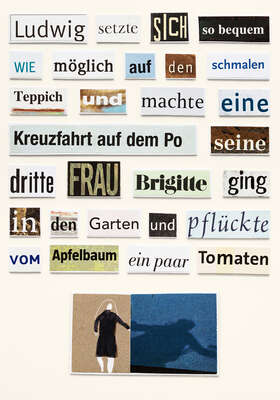Introduction
ABOUT THE WORK
Nobel laureate Herta Müller crystalizes her passion for the unconventional arrangement of words in the form of beautiful, poetic collages. Carefully selected words are arranged into visual poems that are light and humorous yet heavy and thought provoking at the same time – and always accompanied by an illustration. The compositions reveal a side of Müller previously unknown to the public. In her novels, the writer from the Romanian part of the Banat region addresses life under a dictatorship, repression, alienation, and fear. In her collages, by contrast, she allows herself to be guided by the words at hand, giving in to chance. The results are a constant surprise.
Müller’s unique way with words combines with the typography, colours and patterns of the paper. The expressions are given their own tone, their own unique resonance, through the smallest variations in font. The compositions can be enjoyed even without reading them. Herta Müller creates a new space for interpretation, arousing in us an appreciation for words and their individual sounds. The writer herself compares her poetic images to the pamphlets of the past. “Where I grew up, in Romania, under a dictatorship, it was impossible to make pamphlets using typewriters. They had to be registered with the police. We took anything we could find and simply glued it together”, Müller explained to German magazine Der Spiegel in 2012.
ABOUT THE ARTIST
Herta Müller and her poignant, powerful works of prose belong amongst the greats of international literature. In addition to the Nobel Prize for Literature, which she was awarded in 2009, the writer’s other awards include the International IMPAC Dublin Literary Award (1998), the Berlin Literature Prize (2005), and the Grand Cross of Merit of the Federal Republic of Germany (2010). In 2010, Munich’s Literaturhaus dedicated an exhibition to Müller: Der Kalte Schmuck des Lebens (The Cold Jewellry of Life), as conceived by Ernest Wichner.
TECHNIQUE
Whether she extracts the words from newspapers or magazines, what matters to Herta Müller is form, colour and, above all, the word itself. She carries her cutting board around with her everywhere, a habit that enabled her to catalogue and file hundreds of thousands of words during the 1990’s. For each individual poetic puzzle, she allows herself an area no larger than a postcard, keeping the space for her personal linguistic discoveries quite compact.
It would be a fallacy, however, to view this size limitation as restrictive. In fact, it is quite the opposite. When Müller describes the shuffling and re-arranging of the words, and how their meanings consequently change, an almost childlike happiness emerges. Her construction of the visual poems is “sensual and unpredictable”, Müller explains. “I bring completely normal words together. And then, out of the blue, they sparkle!”
Hannah Hör
Bio
| 1953 | Born in Nițchidorf, Romania |
| 1973-1976 | Studied German and Romanian Philology at West University of Timișoara, Romania |
| 1976-1979 | Worked as a translator and teacher. Fired in 1979 for refusing to cooperate with the Securitate, the Romanian secret police. |
| 1987 | Emigrated to Germany |
| 1995 | Became a member of the German Academy for Language and Literature, Darmstadt, Germany |
| 1998 | Brothers Grimm Guest Lecturer at the University of Kassel, Germany |
| 2001 | Poetics Docent, Tübingen, Germany |
| 2005 | Heiner Müller Guest Lecturer at Free Universtiy of Berlin, Germany |
| 2007-2008 | Residence at the Internationales Künstlerhaus Villa Concordia in Bamberg, Germany |
| 2009 | Nobel Prize in Literature |
Awards
| 2010 | Order of Merit of the Federal Republic of Germany |
| 2009 | Nobel Prize in Literature |
| Franz Werfel Human Rights Award |
| 2004 | Konrad Adenauer Foundation Literature Prize |
| 2002 | Carl Zuckmayer Medal |
| 1999 | Franz Kafka Prize |
| 1998 | International IMPAC Dublin Literary Award |
| 1997 | Ricarda Huch Prize |
| 1995 | Aristeion Prize, Literature Prize of the European Union |
| 1994 | Kleist Prize |
| 1984 | Aspekte Literature Prize |
Exhibitions
Solo Exhibitions
| 2010 | Herta Müller. Der kalte Schmuck des Lebens, Literaturhaus München, Munich, Germany |
Group Exhibitions
| 2013 | Wortkünstler/Bildkünstler, Internationale Tage, Ingelheim am Rhein, Germany |
| Wortkünstler/Bildkünstler, Museum Behnhaus, Drägerhaus, Lübeck, Deutschland |


























